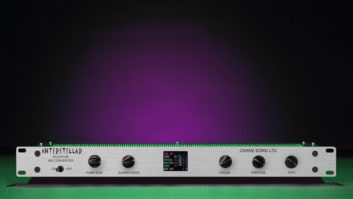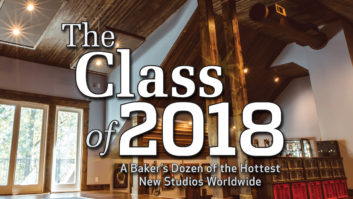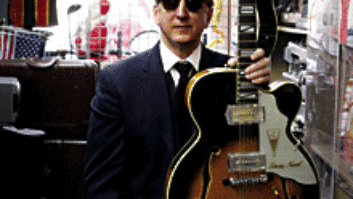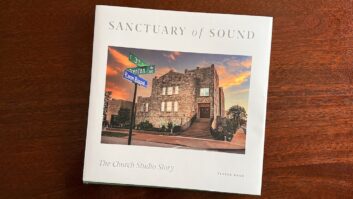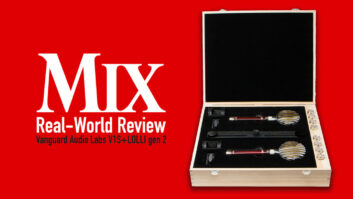Retro Instruments’ Revolver is the company’s latest all-tube processor, having started out as an experiment back in 2011. It seems that Retro’s Phil Moore was not satisfied with it as a viable product until the 2018 Winter NAMM Show, when he showed the first units. Revolver fits perfectly into the Retro Instruments product line and upholds the company’s unwritten mission of building—to the highest-quality standards—the “new classics” that recall the most coveted and vintage audio gear of yesteryear.
Revolver is a dual-channel version of the single-channel, British-modified, American Altec 436C compressor. In Retro Instruments style, Revolver is homage as well as reimagined; compared to the 1950s Altec units, it is greatly improved in all ways, with many needed modern features and improved reliability required for today’s tracking, mixing and mastering work.
Revolver Revealed
Like all Retro Instruments gear, Revolver is overbuilt to last years. It weighs 22 pounds and comes in a steel 2 RU cabinet painted in chip-resistant gray. Even the inside of the top cover is painted, with the bordering edges left as bare metal for a good electrical shield connection to help minimize noise and hum induced from other gear.
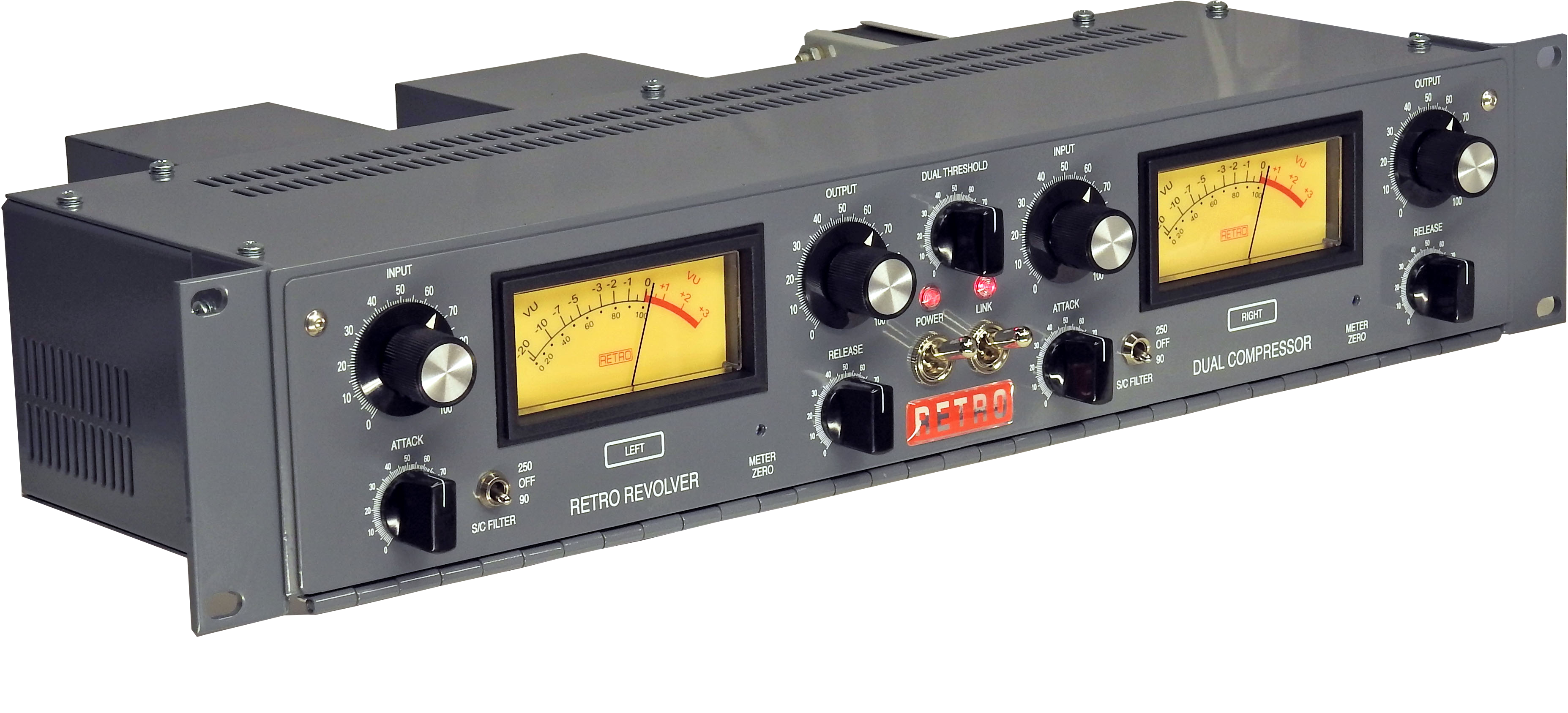
The front panel has the two channels side-by-side, dominated by two large VU meters in custom bezels. Each channel has its own large input and output level control knobs (Alpha pots) and large size (Carling) toggle switches for power on/off and stereo channel linking. Small Alco toggle switches for each channel select a highpass sidechain filter. It has a 6 dB/octave curve switchable between 90 or 250 Hz.
The original Altec 436C was a three-tube circuit. Revolver uses a solid-state sidechain circuit to replace the 6AL5 tube detector used in the Altec, though it retains the same 6BC8 input and 6CG7 output tubes. There are many dual triode tubes that can be substituted, as Retro has a vast NOS supply of American-made tubes (primarily because they were popular television tubes).
The rear panel of Revolver mimics the Altec with horizontally mounted tubes and transformers for proper cooling. The four tubes (two for each channel) are located between and protected by two taller custom output transformers located inside of steel box shields. The output transformers’ laminated cores are oriented 90-degrees from the core of the custom AC power transformer. Part of Revolver’s sonic “secret sauce” revealed to me is that there are separate power supply rectifiers and filtering for each of the two channels. Only the AC power transformer is shared.

There are individual controls for variable attack and release time settings. The original 436C had a fixed attack time of 50 ms and adjustable release times of up to 1.3 seconds. Revolver expands both parameters with an adjustable attack time range from fastest at 2 ms to slowest at 40 ms. Variable release times range from fastest at 0.2 seconds to slowest at 2 seconds.
Threshold/Ratio Control Workflow
Revolver’s single Dual Threshold knob controls both the unit’s compression ratio and threshold for both channels at the same time. This control is located in the exact center of the front panel and, at first take, was puzzling to me. But this control and Revolver’s workflow made elegant sense to me the first time I used it.
Related: Review: Retro Powerstrip Channel Strip, by Kevin Becka, Jan. 1, 2012
Revolver’s ratios range from a 1.5:1 (full CCW) to 5:1 (full CW). A good starting point is to set the Dual Threshold knob fully CCW so that the compressor’s threshold is least-sensitive. By using the input level control and driving more level into the detector, not only will you control the saturation of the fully differential tube path, but be able to compress to any amount using a low 1.5:1 ratio. As you turn the Dual Threshold clockwise, you get more compression at higher and higher ratios, although it may require readjusting the input gain control and the unit’s output level.
Just as in the Altec 436C and other compressors of that era, adjusting all the controls of Revolver was standard workflow for optimum operation. Also like those classic processors, Revolver has no hardwire bypass. That said, I do wish there were a way to switch off the sidechain (for no compression) so audio could be passed through it for analog “color.”
Let There Be Drums
In the studio I tried Revolver connected in three ways: As a parallel processor, patched line in/out using the console, and as a delay-compensated hardware insert when mixing in Pro Tools HDX.
For a drum kit, I used Revolver as a hardware stereo insert but first I fed Pro Tools’ signal generator plug-in (-18 dBFS = 0 dB) to verify the unit was passing signal at unity with Dual Threshold at fully CCW (no compression). Revolver’s meters measure gain reduction only so I used PSPaudioware’s Triple Meter plug-in to measure the oscillator’s signal going to and from Revolver. As a starting position, I would arbitrarily set both output knobs to “50” and then adjust the input knobs to get an equal 0 dB back into Pro Tools. Both these controls are subject to big changes when getting a sound.

I started with routing a mix of all the drum tracks into Revolver. I had nearly the fastest release time and the slowest attack time settings, and threshold was at minimum. I raised the input level up considerably to drive more level in to produce a rich color yet not sound too rubbery and squashed. I was looking to increase the average loudness and the level of detail.
The sidechain filter was at 90 Hz, and I used no stereo link so as to hear clearly the panned localizations of the different cymbals and tom hits. I liked using the single Dual Threshold control to quickly set the amount of compression and ratio at the same time—when getting sounds quickly during a recording session, this is awesome.
Listening to the tempo and the drummer’s playing style and fills, I came up with the appropriate release time setting at 9 o’clock and Dual Threshold at about 3 o’clock. The overall sound of the kit “tightened up” with more authority, and the kick and snare sounded much firmer and more centered. I did work on the internal balance of the drum tracks and found subtle cymbal work became more present. Unless I cranked up more compression, cymbal crashes did not get overly loud. I was working with a great drum kit recording, so Revolver showed off the sound of the room, the sound of the kit and skill and subtleties of the drummer.
Bass, Acoustic, Electric Guitars
With Dual Threshold straight up at 12 noon, attack time at the slowest and release at 12 noon, the 90 Hz sidechain filter position, I quickly reined in a bright-sounding Fender bass that was played with a pick. As it should be for a recording engineer, setting up Revolver is a juggling act between the input level, Dual Threshold and release controls so that the sustaining notes do not release too quickly and get loud prematurely. With up to 10 dB of gain reduction on the meter, the bass sounded clean and was still dynamic as recorded, but it was more constant in level, with the bass player’s funky finger vibratos better heard within the mix.
I just “touched” a stereo-tracked acoustic guitar with Dual Threshold set fully CCW, input level halfway up, release at fastest, attack at 11 o’clock, 90 Hz filter, and stereo link on. For this jangling guitar part, using Revolver patched before the EQ and compressing only about 3 dB max, it was just perfect to keep this main guitar bright and constant within the track as required. Revolver used in this subtle way can only be a winner every time.
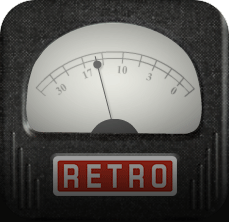
I wanted to explore adding coloration to some pedestrian-sounding electric guitar parts. The guitarist played a melody for eight measures of a verse and then a second guitarist joined in to double-tracked for the last four measures for the build up to the chorus. I set both of Revolver’s channels the same and saw the VU meter “flatten” at 20 dB or more of compression at all times!
Related:
• Review: Retro Instruments 2A3 Passive Equalizer, by Michael Cooper, March 1, 2010
• Field Test: Retro Instruments Sta-Level Compressor, by Kevin Becka, Feb. 1, 2007
The sound is not unlike a stomp pedal compressor except you could adjust the release time for less distortion. I had threshold, attack and release at their midway positions, 90 Hz filter, and input gain controls all the way up. With this much compression, if I linked channels, you would not hear the (otherwise loud) attack of the second guitar at its entrance just before the chorus.
Stereo Bus
In my mixing process, I often switch in a stereo compressor just as I am committing to basic balances and beginning my fader automation moves. Revolver is almost mistake-proof: I often see up to 5 dB (or more) of gain reduction and still have the mixes sound great. I am free to reset the gain reduction as needed and not have the mix suddenly fall apart.
I tried Revolver on the stereo insert of my SSL Sigma, as well as on the output from A-Designs Audio’s Mix Factory—these are both analog summing systems. It was amazing to see massive amounts of gain reduction easily added to full song mixes of rock, R&B/jazz ballads, and orchestral productions and still have it sound completely musical.
I used the 250 Hz sidechain filter for the R&B tracks to keep the bass and kick drum prominent while the rock tracks were okay with the 90 Hz setting. Revolver’s Dual Threshold control makes it easy to dial in just the right touch of thick saturation and density, add a subtle amount of “glue,” or crank it more to “sand down” a spikey bright track.
Almost any way you set it, Revolver’s smooth and rich sound comes so easily. I am highly recommending this new classic for all uses, but I like it especially on drum kits, bass, background vocals and for lightly controlling acoustic guitars.
Product Summary
Company: Retro Instruments
Product: Revolver
Website: www.retroinstruments.com
Price: $2,995 MSRP
Pros: Musical euphonic compression
Cons: Dual threshold/ratio control might take getting use to for some
